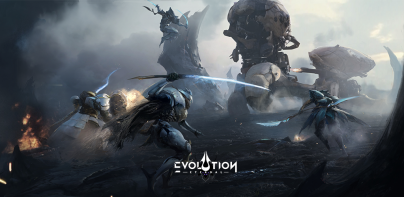


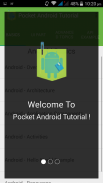

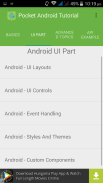

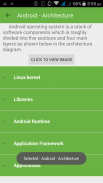

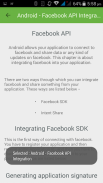
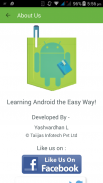
Pocket Android Tutorial Free

Beschreibung von Pocket Android Tutorial Free
Pocket Android Tutorial is a guide to learn Android application development. It covers basic to advanced topics and some useful API examples of Android that enables user to start designing and creating their own applications!
Core Java knowledge is recommended though.
Java and XML code snippets can be seen for each API example and Images for examples and outputs are also available to users for an easy understanding of the API stuff.
In the first part, A brief about Android OS and building blocks like Activities, Services, Broadcast Receivers, Content Providers are described.
Then comes the Android UI part that describes the widgets like Buttons, TextView, EditText, Radio Buttons, Listview, and various layouts like Relative Layout, Linear Layout, Absolute Layout, Table Layout, etc. It also covers Event Listener and Event Listener registration.
Then comes the Advanced Android concepts like Location Based Services that use GPS to know current location of any person, place etc. It covers Drag and Drop API that gives a good GUI feel to the end users. It also covers concepts like Notifications, Sending Email, Phone Calls, and Publishing Applications on Play Store!
The last section is Android Examples that has some important API examples like WebView for rendereing Webpages, SQLite Database for storing local data inside Android device, Facebook API support, JSON Parser API, Animations, Alert Dialogs, etc.
</div> <div jsname="WJz9Hc" style="display:none">Taschen Android Tutorial ist eine Anleitung für Android-Anwendung Entwicklung zu lernen. Es deckt einfachen bis zu anspruchsvollen Themen und einigen nützlichen API Beispiele für Android, die Benutzer ermöglicht, Beginn der Planung und Erstellung von eigenen Applikationen!
Core-Java-Wissen wird aber empfohlen.
Java- und XML-Code-Snippets für jede API Beispiel zu sehen ist und Bilder zum Beispiele und Ausgänge sind auch für eine einfache Verständnis der API-Sachen für Benutzer verfügbar.
Im ersten Teil, Eine kurze über Android OS und Bausteine wie Aktivitäten, Dienste, Rundfunkempfängern und Content Provider werden beschrieben.
Dann kommt der Android UI Teil, der die Widgets wie Schaltflächen, Textview, EditText, Optionsfelder, Listenansicht, und verschiedene Layouts wie Relative Layout Linear-Layout, Absolute-Layout, Tabellenlayout, etc. Es umfasst auch Ereignis-Listener und Ereignis-Listener-Registrierung beschrieben.
Dann kommt die erweiterte Android Konzepte wie Location Based Services, die GPS verwenden, um aktuellen Standort einer Person kennen, setzen usw. Veranschlagt sind Drag & Drop-API, die eine gute GUI für die Endbenutzer das Gefühl verleiht. Sie decken auch Konzepte wie Benachrichtigungen, Senden von E-Mail, Telefon, Veröffentlichen von Anwendungen auf Play Store!
Der letzte Abschnitt ist Android Beispiele, die einige wichtige API Beispiele wie WebView für rendereing Webpages hat, SQLite-Datenbank zum Speichern von lokalen Daten im Android-Gerät, Facebook-API-Unterstützung, JSON-Parser-API, Animationen, Alert-Dialoge usw.</div> <div class="show-more-end">







